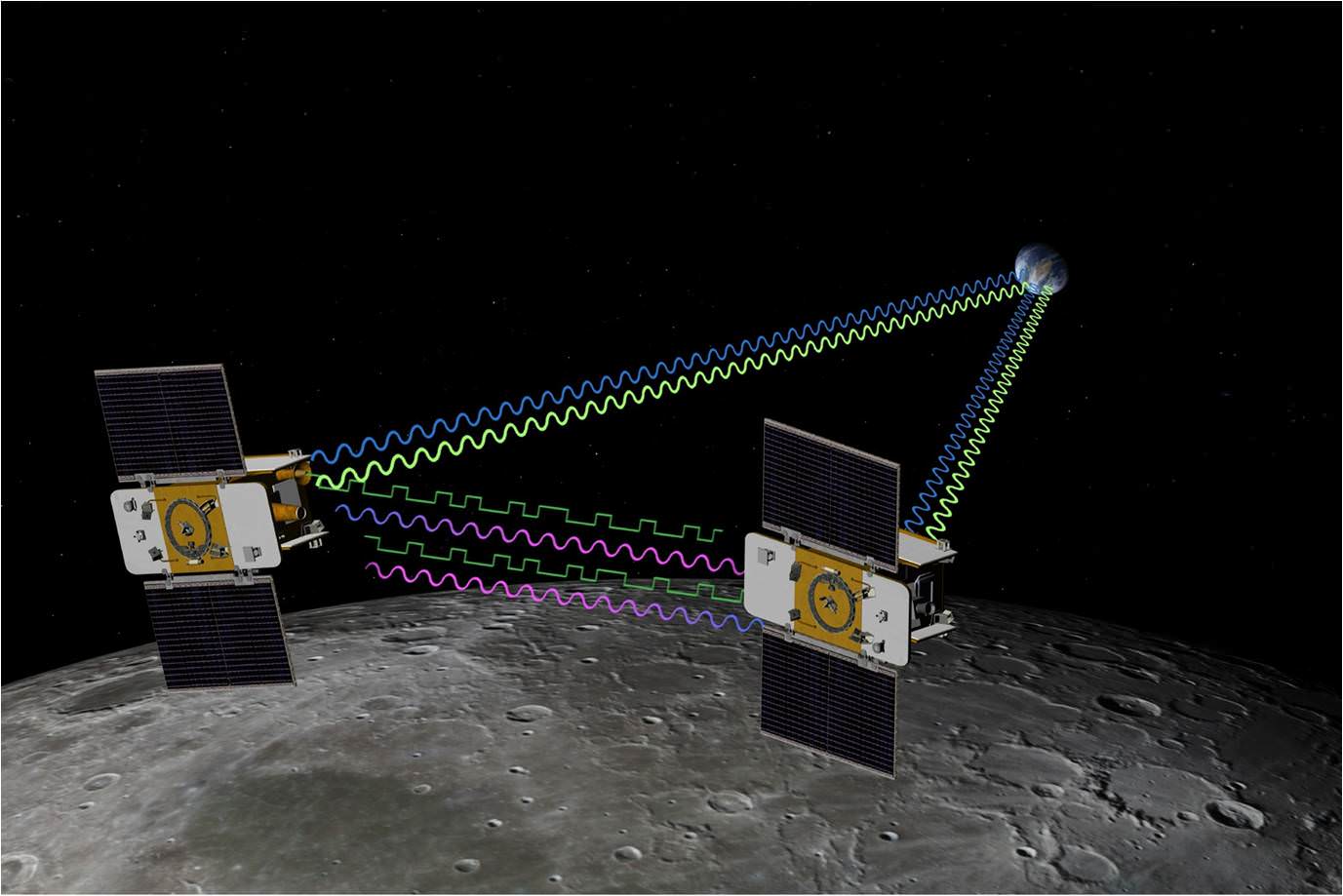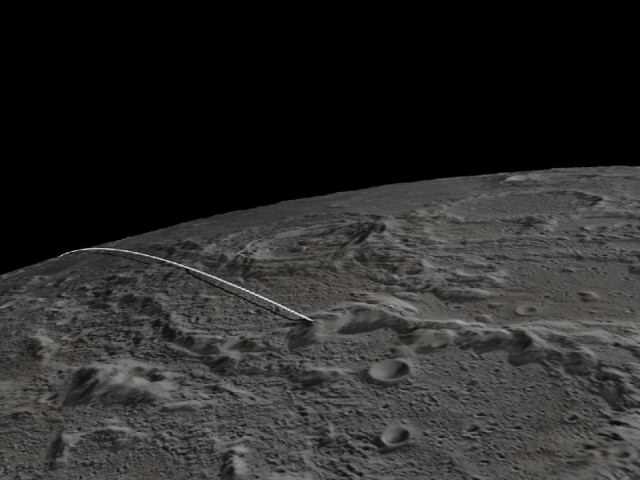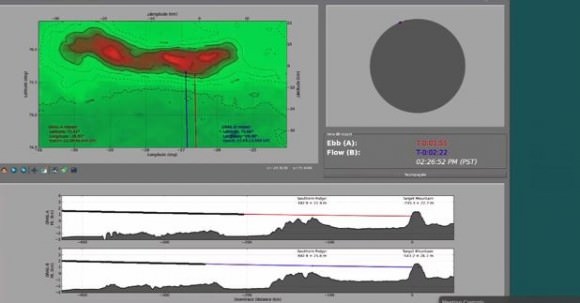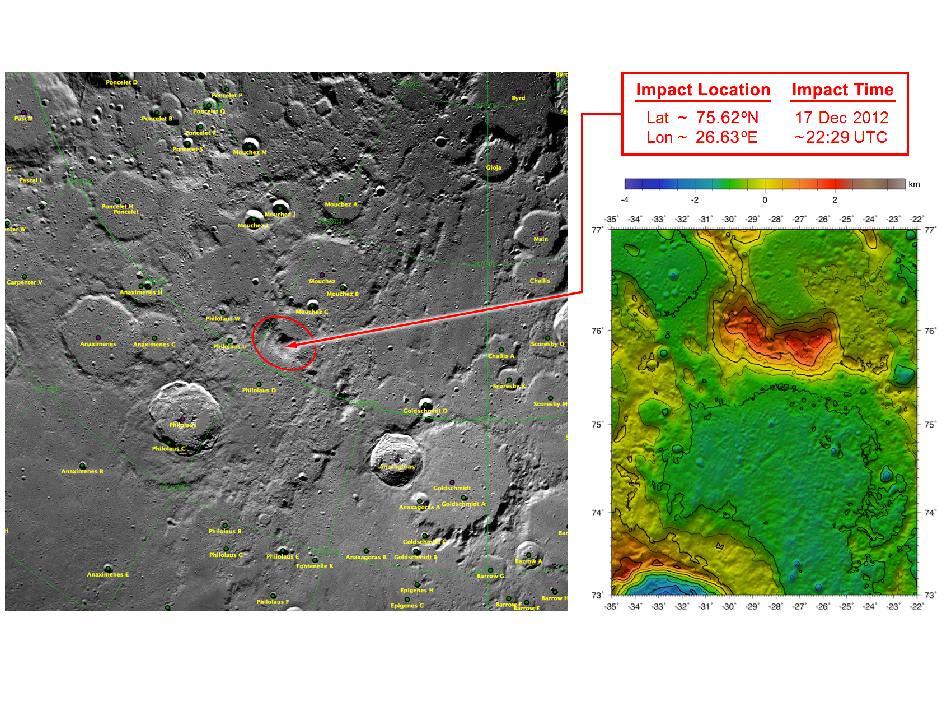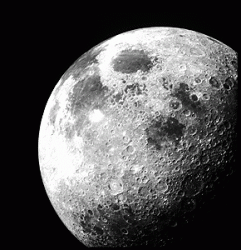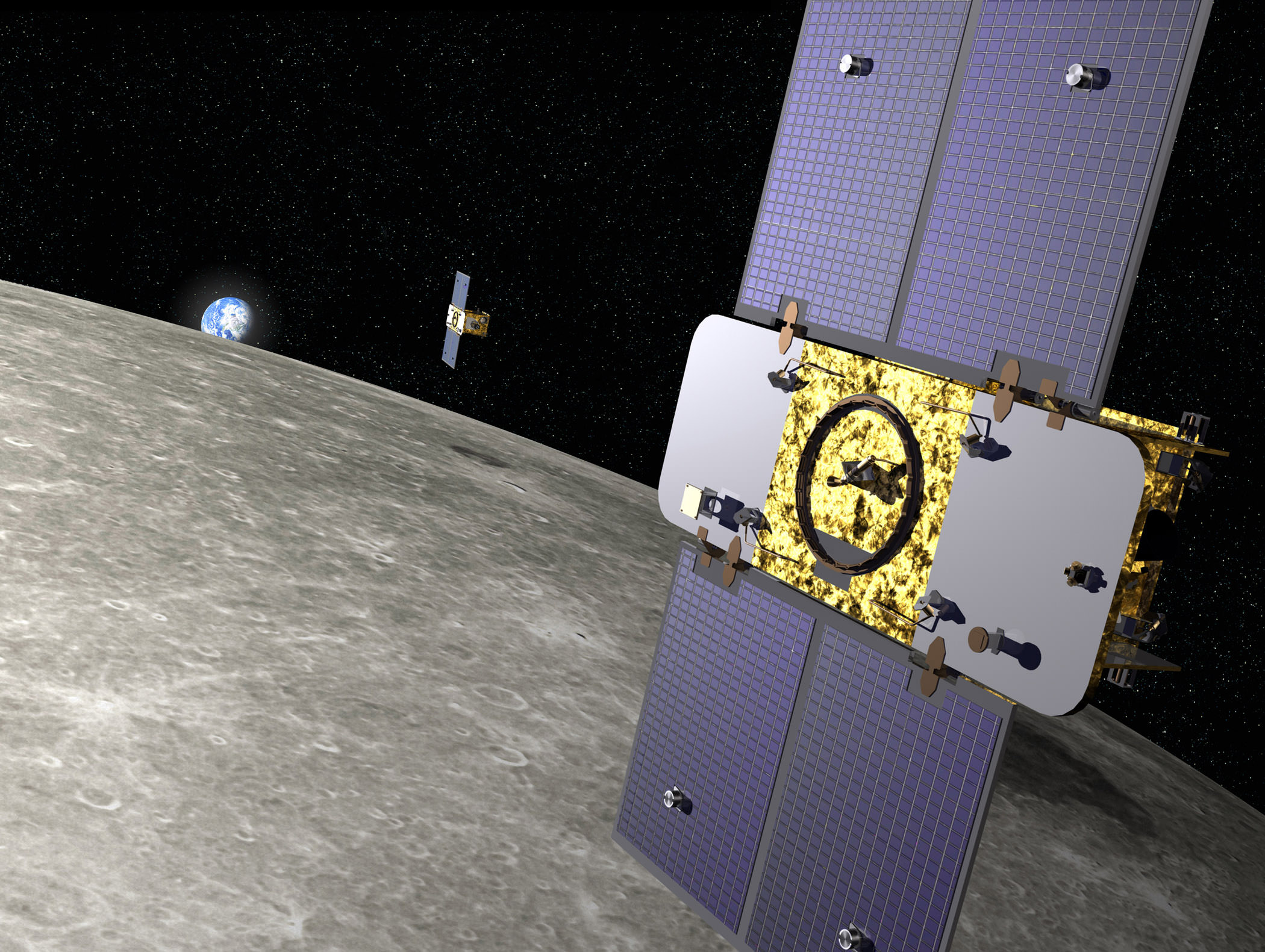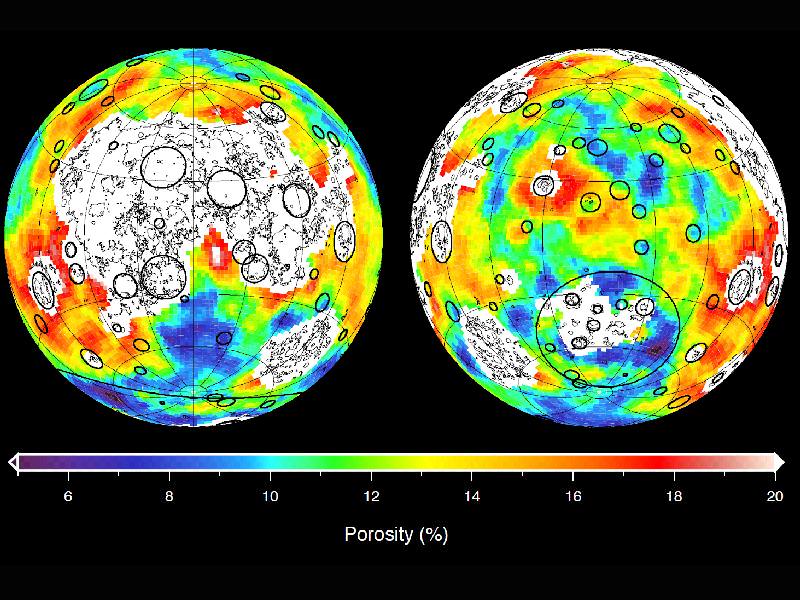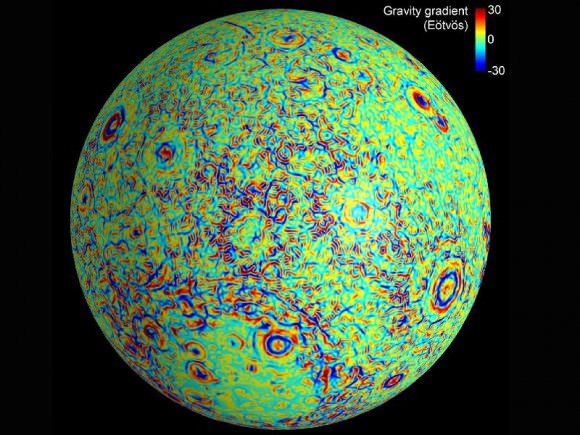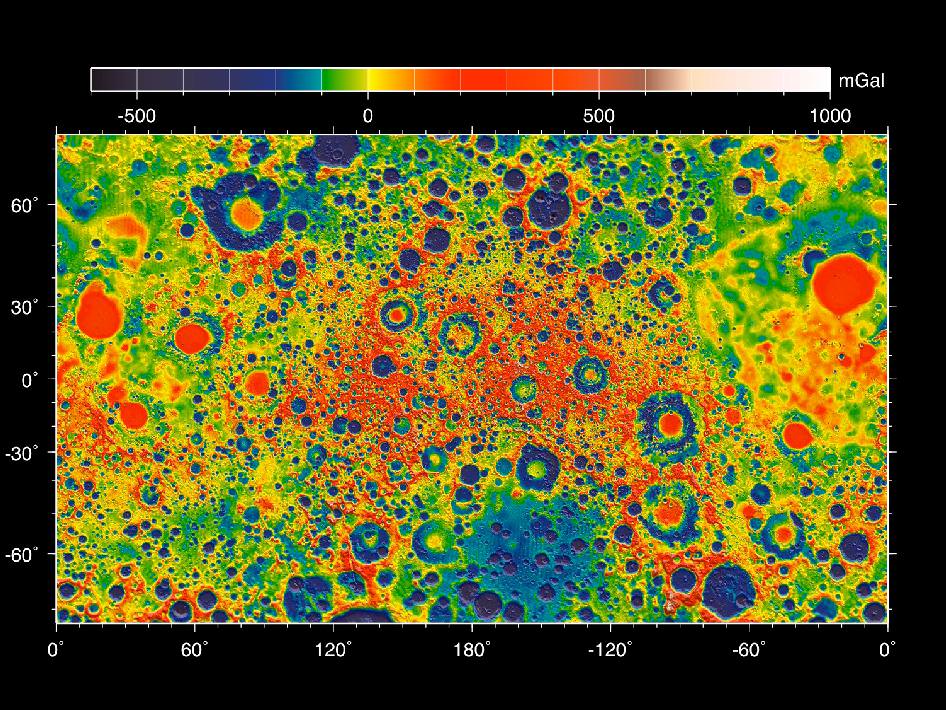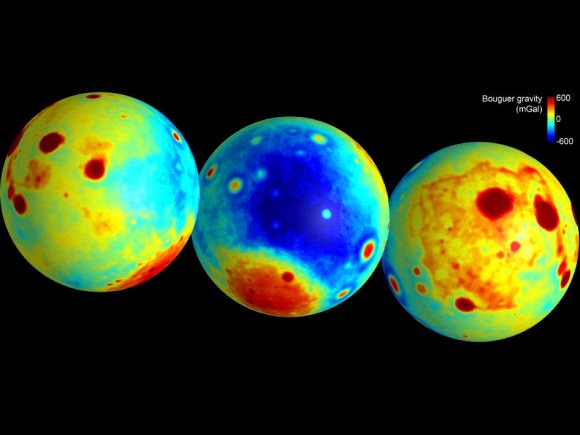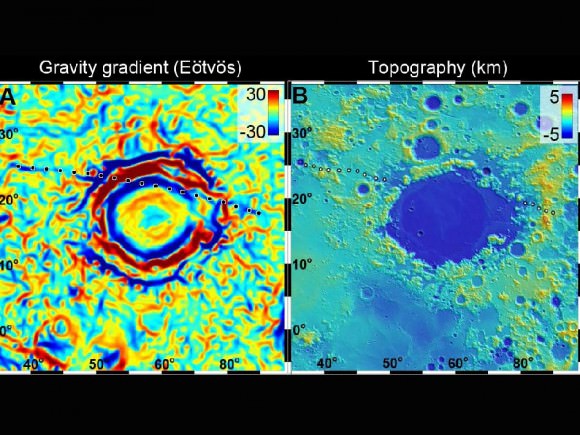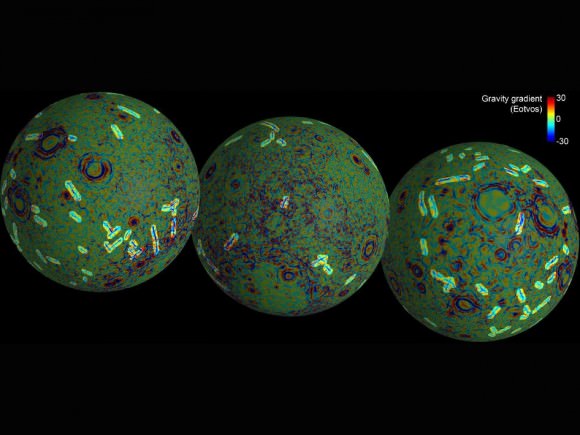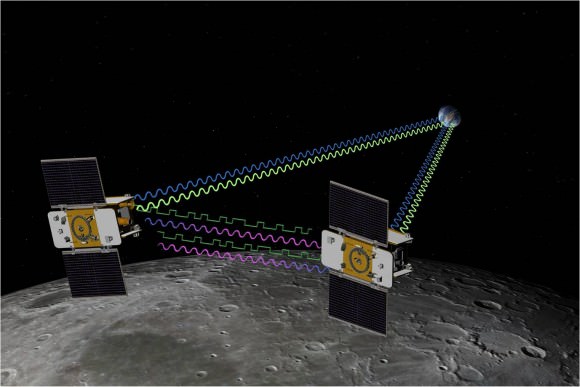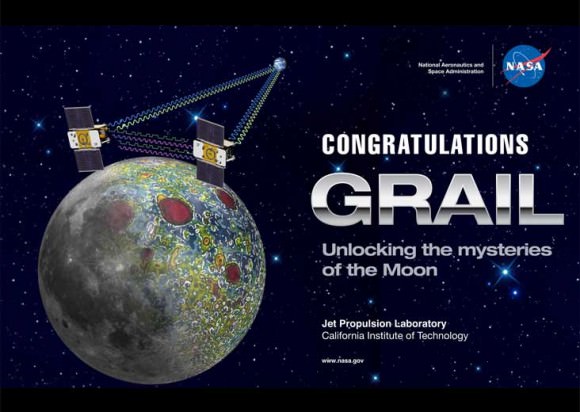As a fond farewell, here are some of the final images taken by the GRAIL MoonKAM educational cameras on board Ebb and Flow, the twin spacecraft for the mission. This footage was shot just three days prior to when the mission ended with the planned impacts on a rim of a crater near the lunar north pole. At that point in the mission, the spacecraft had lowered their orbit to only about 11 km above the lunar surface. While these images aren’t of the highest of resolution, they provide a great sense of what it would be like to orbit close to the Moon. Additionally, they are an inspiration to school children. With MoonKAM (Moon Knowledge Acquired by Middle School Students) the cameras took more than 115,000 total images of the lunar surface, and imaging targets were proposed by middle school students from across the country and the resulting images returned for them to study.
The two probes were purposely crashed into the Moon because they no longer had enough altitude or fuel to continue science operations.
End of Mission: GRAIL Spacecraft Impact a Mountain on the Moon
The planned path of the GRAIL spacecrafts’ final orbit. Credit: NASA
“So long, Ebb and Flow, and we thank you,” said GRAIL project manager David Lehman of NASA’s Jet Propulsion Laboratory after the twin GRAIL spacecraft completed a planned formation-flying double impact into the southern face of 2.5-kilometer- (1.5-mile-) tall mountain on a crater rim near the Moon’s north pole. Mission team members estimate the two spacecraft were traveling at a speed of 1.7 kilometers per second (3,760 mph), and likely broke apart on impact. NASA said that most of what remains of the washing machine-sized spacecraft are probably buried in shallow craters, and the size of those craters will hopefully be determined when NASA’s Lunar Reconnaissance Orbiter is able to image the impact site in about two weeks.
NASA has honored the GRAIL team’s request to name Ebb and Flow’s impact sites after astronaut Sally Ride, who passed away earlier this year. She was America’s first woman in space and a member of the GRAIL mission team.
A simulation of the GRAIL impacts:
Impact occurred at 10:28:51 UTC (5:28:51 p.m. EST) and 10:29:21 UTC (5:29:21 p.m. EST). Right now it is night at the impact site, so sunlight should return within two weeks, enabling imaging of the site. LRO also took “before” images of the site during previous daylight orbits.
The impact marked a successful end to the GRAIL(Gravity Recovery and Interior Laboratory)mission, which in just a 90-day prime mission generated the highest-resolution gravity field map of any celestial body — including Earth — and determined the inner crust of the Moon is nearly pulverized.
“Ebb and Flow have removed a veil from the Moon,” said GRAIL principal investigator Maria Zuber during a televised commentary of the impacts today, adding that the mission will enable discoveries for years to come.
Data from GRAIL’s extended mission and main science instruments are still being analyzed, and the findings will provide a better understanding of how Earth and other rocky planets in the solar system formed and evolved.
GRAIL was NASA’s first planetary mission to carry cameras fully dedicated to education and public outreach. Ride, who died in July after a 17-month battle with pancreatic cancer, led GRAIL’s MoonKAM (Moon Knowledge Acquired by Middle School Students) Program through her company, Sally Ride Science. The camera took more than 115,000 total images of the lunar surface, and imaging targets were proposed by middle school students from across the country and the resulting images returned for them to study.
“Sally was all about getting the job done, whether it be in exploring space, inspiring the next generation, or helping make the GRAIL mission the resounding success it is today,” said Zuber. “As we complete our lunar mission, we are proud we can honor Sally Ride’s contributions by naming this corner of the Moon after her.”
Last Friday, Ebb and Flow, the two spacecraft comprising NASA’s Gravity Recovery and Interior Laboratory (GRAIL) mission, were commanded to descend into a lower orbit that would result in an impact Monday on a mountain near the Moon’s north pole.
Fifty minutes prior to impact, the spacecraft fired their engines until the propellant was depleted. The maneuver was designed to determine precisely the amount of fuel remaining in the tanks. This will help NASA engineers validate computer models to improve predictions of fuel needs for future missions.
Screenshot of engineering data showing trajectory of the two GRAIL spacecraft about 2 minutes before Ebb’s impact. Via NASA TV.
“Ebb fired its engines for 4 minutes 3 seconds, and Flow fired its for 5 minutes 7 seconds,” Lehman. “It was one final important set of data from a mission that was filled with great science and engineering data.”
Launched in September 2011, Ebb and Flow had been orbiting the moon since Jan. 1, 2012. The probes were intentionally crashed into the lunar surface because they did not have sufficient altitude or fuel to continue science operations.
Endgame: GRAIL Spacecraft to Slam into Lunar Crater Rim on December 17
The GRAIL mission will come to a dramatic end on Monday as the two spacecraft will be commanded to crash into the rim of an unnamed crater near the Moon’s north pole. This is all according to plan, as the two spacecraft are running out of fuel after being in lunar orbit since New Year’s Day 2012.
“We successfully completed our primary science mission,” said Principal Investigator Maria Zuber, “ and, frankly, in my wildest dreams I don’t think this mission could have gone any better than it has. But when you orbit a planetary body that has lumpy gravity field, you use a lot of fuel.”
On Dec. 17 at about 5:28 EST, the spacecraft dubbed Ebb will undergo a controlled impact into a 2 km high “mountain, a rim of a crater that has been buried in ejecta near north pole of the Moon (coordinates are 75.62°N, 26.63°W). About 30 seconds later Flow will impact, about 40 km apart.
Both spacecraft will hit the surface at 3,760 mph (1.7 kilometers per second). No imagery of the impact is expected because the region will be in shadow at the time.
These maps of Earth’s moon highlight the region where the twin spacecraft of NASA’s Gravity Recovery and Interior Laboratory (GRAIL) mission will impact on Dec. Image credit: NASA/GSFC
Additionally, Gruber said that while they hope the Lunar Reconnaissance Orbiter will be able to observe the impact region (at the very least image the region both before and after impact), they don’t expect to there to be a “flash” visible from Earth, and do not believe there will be a significant chance of doing science by kicking up volatiles like LCROSS did, mostly because of the GRAIL spacecraft small size (each about the size of a washing machine) and because of the low angle of impact. The spacecraft have been at a low orbit averaging about 11 km above the surface this week, to be able to map at a high resolution before the fuel ran out.
They chose a mountain-side “since we’re coming in at angle of 1.5 degrees, it would only have left “skid marks” on level surface,” Zuber said. “There was interest in the team in impacting a structure, or a wall, so we could learn about mechanical properties of a crater rim. We’ll be looking at the rim of the crater and understanding how much is intact rock and how much is broken up. It will be very low probability but high scientific payoff if it works, if any volatiles they would be liberated from the impacts.”
The twist on this observation, Zuber said, is this crater is in sunlight most of the time, so if any volatiles come out, it would be surprising.
GRAIL project manager David Lehman said that Friday morning (December 14) the spacecraft will each be executing a maneuver will targeting the impact site, that will also position them to avoid what are called “historic heritage sites,” where the US and Russians have put soft landers on the Moon.
Then they’ll turn off the science instruments, followed by a series of engineering demonstrations to help with future missions over the weekend. About 54 minutes before impact, they’ll burn the remaining fuel to complete the last maneuver.
Lehman said there is a bit of challenge in hitting the crater rim. “We need to clear a ridge and then keep from going through a gap in the rim, because otherwise it would keep going and hit the far side of the Moon.”
Lehman added he was sad to see the mission end. “I’m kind of hoping tonight that a gas station will pull up to our spacecraft and refuel it.”
During their prime mission, from March through May, Ebb and Flow collected data while orbiting at an average altitude of 34 miles (55 kilometers). Their altitude was lowered to 14 miles (23 kilometers) for their extended mission, which began Aug. 30 and sometimes placed them within a few miles of the moon’s tallest surface features.
The duo’s successful prime and extended science missions generated the highest-resolution gravity field map of any celestial body. The map will provide a better understanding of how Earth and other rocky planets in the solar system formed and evolved.
“It is going to be difficult to say goodbye,” said Zuber. “Our little robotic twins have been exemplary members of the GRAIL family, and planetary science has advanced in a major way because of their contributions.”
One Spacecraft Captures Another in Lunar Orbit
This is awesome! It is the first footage of one orbiting robotic spacecraft taken by another orbiting robotic spacecraft at Earth’s moon. “Flow,” one of two satellites making up NASA’s Gravity Recovery and Interior Laboratory (GRAIL) mission, captured this video of NASA’s Lunar Reconnaissance Orbiter (LRO) as it flew by at a distance of about 20 kilometers (12 miles) on May 3, 2012. LRO is the single bright pixel that moves from top left to bottom right. The Moon’s south polar region is in the background, much of which is in darkness.
This footage was taken by Flow’s “MoonKam” camera, which is an educational camera run by the GRAIL team and Sally Ride Science.
Herschel Spacecraft Won’t “Bomb” the Moon, But GRAIL Will
Artist concept of Ebb and Flow, the two GRAIL spacecraft in orbit of the Moon. Credit: NASA
The Herschel space telescope is slated to be decommissioned next March as the observatory’s supply of cryogenic helium will be depleted. One idea for “disposing” of the spacecraft was to have it impact the Moon, a la the LCROSS mission that slammed into the Moon in 2009, and it would kick up volatiles at one of the lunar poles for observation by another spacecraft, such as the Lunar Reconnaissance Orbiter. However, that idea has been nixed in favor of parking Herschel in a heliocentric orbit. But don’t be disappointed if you were hoping for a little lunar fireworks. There will soon be a double-barreled event as the twin GRAIL spacecraft will impact the moon’s surface on December 17, 2012.
NASA will be providing more information about the GRAIL spacecrafts’ impacts at a briefing on Thursday, but the Gravity Recovery and Interior Laboratory (GRAIL) team said last week that they were still formulating ideas for the impact scenario, and looking at the possibility of aiming the crashes so they are within the field-of-view of instruments on LRO. The two spacecraft are running out of fuel – Principal Investigator Maria Zuber said they have to do three maneuvers every day to keep the spacecraft from slamming into the Moon on their own – and earlier this year the duo were lowered from their prime mission orbit of 55 kilometers above the Moon to 23 km, and this week were lowered to 11 km to enable even higher resolution data.
The two spacecraft have been providing unprecedented detail about the Moon’s internal structure as they send radio signals to each other and monitor any changes in distance between the two as they circle the Moon. Changes as small as 50 nanometers per second have been measured, and last week the team detailed how they were able to create the most detailed gravity map of the Moon, as well as make determinations that the Moon’s inner crust is nearly pulverized.
We’ll provide more information about the GRAIL impacts when it becomes available, but preliminary details are that the impacts will take place on Dec. 17 at 19:28 UTC (2:28 p.m. EST).
The impact by LCROSS (Lunar Crater Observation and Sensing Satellite) confirmed the presence of water ice and an array of volatiles in a permanently shadowed crater at the Moon’s South Pole, and it is expected GRAIL would be targeted for similar observations.
Artist’s concept of Herschel at the L2 libration point one million miles from Earth. Credit: ESA
The Herschel team had said earlier this year that because the cryogenic superfluid helium coolant is running out — and the spacecraft needs to be at temperatures as low as 0.3 Kelvin, or minus 459 degrees Fahrenheit to make its observations — one idea of getting rid of the spacecraft would be to impact it on the Moon. This week, they posted on the Herschel website that ‘the lunar impact option is feasible, but carries an additional cost on top of that of the heliocentric orbit option. The ESA Executive has decided that the Herschel spacecraft will be “parked” indefinitely in heliocentric orbit.”
The Herschel operational large halo orbit around L2 is unstable, and so the orbit needs regular “maintenance,” and consequently, after end-of-helium (expected in March 2013), the spacecraft will need to be “parked” somewhere else with no need of orbit maintenance.
Herschel team member Chris North told Universe Today that the mission operators needed to get some engineering tests done to determine if the Moon impact was feasible. “Basically they hand it over to engineers who do things that are considered too risky during the scientific mission itself – e.g. test the attitude control to its limits to see what it can withstand!” North said via email. He added that most people he had spoken with were all for the impact, — having it “go out in a blaze of glory.”
But, surprisingly, the costs for impact are greater than leaving it in a parking orbit for a few hundred years. It’s orbit may have to be maintained again in the future, as some estimates put it at potentially impacting Earth at some point in several hundred years.
And for anyone worried that a lunar impact by the GRAIL spacecraft will “hurt” the Moon, one look at the Moon shows that it has been hit in the past and continues to get impacted by asteroids and meteoroids, with no adverse affect to its orbit.
As LCROSS principal investigator Tony Colaprete said about the LCROSS impact, “What we’re doing with the Moon is something that occurs naturally four times a month on the Moon, whether we’re there or not. The difference with LCROSS is that it is specifically targeted at a certain spot, Cabeus crater,” and that the laws of physics mean there will be a miniscule perturbation.
Even though the Centaur rocket stage that hit the Moon was expect to kick up about 350 tons of lunar regolith, “The impact has about 1 million times less influence on the Moon than a passenger’s eyelash falling to the floor of a 747 jet during flight,” Colaprete said.
The two GRAIL spacecraft are about the size of washing machines, much smaller than the Centaur rocket, so will have less of an impact.
Moon’s Inner Crust Almost Completely Pulverized
This image shows a highly porous crust on the lunar surface, a consequence of fractures generated by billions of years of impact cratering. Credit: NASA/JPL-Caltech/ IPGP
From looking at the Moon’s surface, we know it has taken a beating from asteroids and comets pummeling its surface. But new details from the GRAIL mission reveal the lunar interior just below the surface has been walloped as well, and is almost completely pulverized. This surprising finding, along with the discovery of deep fractures, suggests that in its first billion years, the Moon may have endured a history of massive impacts, more than previously thought. By inference, this means Earth and other terrestrial planets in the Solar System endured huge early impacts, too.
“It was known that planets were battered by impacts, but nobody had envisioned that the [Moon’s] crust was so beaten up,” said Maria Zuber, Principal Investigator for the GRAIL mission. “This is a really big surprise, and is going to cause a lot of people to think about what this means for planetary evolution.”
The new GRAIL data agrees with recent studies that suggest that the Late Heavy Bombardment may have lasted much longer than originally estimated and well into the time when early life was forming on Earth. Additionally, this “late-late” period of impacts — 3.8 billion to 2.5 billion years ago — was not for the faint of heart. Various blasts may have rivaled those that produced some of the largest craters on the Moon, and could have been larger than the dinosaur-killing impact that created the Chicxulub crater 65 million years ago.
From GRAIL’s measurements, Zuber and her team have now stitched together a high-resolution map of the Moon’s gravity (read more about it in our previous article.)
But the resulting map also reveals an interior gravitational field consistent with an incredibly fractured lunar crust. Compared to the surface, the map of the interior looks extraordinarily smooth. Except for the large impact basins, the Moon’s upper crust largely lacks dense rock structures and is instead likely made of porous, pulverized material.
This moon map shows the gravity gradients calculated by NASA’s GRAIL mission. Red and blue correspond to stronger gravity gradients. Image credit: NASA/JPL-Caltech/CSM
GRAIL’s lunar gravity map has also revealed numerous structures on the Moon’s surface that were unresolved by previous gravity maps of any planet, including volcanic landforms, impact basin rings, and many simple, bowl-shaped craters. From GRAIL’s measurements, scientists have determined that the Moon’s crust, ranging in thickness from 34 to 43 kilometers, is much thinner than planetary geologists had previously suspected. The crust beneath some major basins is nearly nonexistent, indicating that early impacts may have excavated the lunar mantle, providing a window into the interior.
“If you look at surface of the Moon and how heavily cratered it is,” said Zuber during a press briefing on Wednesday from the American Geophysical Union conference, “that tells us that all terrestrial planets looked that way, but Earth’s history is not preserved because of atmospheric and erosional processes on our planet. So, if we want to study those early periods, we need to go somewhere else, and the Moon is the perfect place for that.”
Zuber said that from finding an incredible fracturing of the Moon’s upper crust, we now know the crust of other planets likely have these same fractures as well. “We have reason to believe that the fractures on the terrestrial planets are deeper, and perhaps as in case of the Moon, even into the mantle. This effects planetary evolution, such as how planets lose heat,” she said.
Fractures also provide a pathway for fluids.
“Mars has been theorized to have an ancient ocean, and we wonder where it went,” said Zuber. “The ocean could well be underground, and we’ve seen evidence of water underground on Mars. If there were ever microbes on the surface of Mars, they could have gone very deep, so this finding opens up possibilities like that, and really opens a window to the early stages of our Solar System and just how violent a place it was.”
In addition to GRAIL’s discoveries, Zuber said another major accomplishment has been the performance of the spacecraft themselves. To achieve the mission’s science goals, the two probes, which can travel more than 200 kilometers apart, needed to be able to measure changes in the distance between them to within a few tenths of a micron per second. But GRAIL actually outperformed its measurement requirements by about a factor of five, resolving changes in spacecraft distance to several hundredths of a micron per second.
“On this mission, with two spacecraft, everything had to go perfectly twice,” Zuber says, adding proudly, “Imagine you’re a parent raising a twins, and your children sit down at the piano and play a duet perfectly. That’s how it feels.”
GRAIL First Results Provide Most Precise Lunar Gravity Map Yet
This map shows the gravity field of the moon as measured by NASA’s GRAIL mission. Image credit: NASA/ARC/MIT
The first science results from NASA’s twin GRAIL lunar orbiters provide incredible detail of the Moon’s interior and the highest resolution gravity field map of any celestial body, including Earth.
The Gravity Recovery and Interior Laboratory (GRAIL) data shows ancient internal structures that were previously unknown, provides details that are up to five orders of magnitude better than previous studies of the Moon, and delivers unprecedented information about the Moon’s surface and gravity field.
The twin spacecraft, nicknamed Ebb and Flow, send radio signals to each other and any changes in distance between the two as they circle the Moon are measured, down to changes as small as 50 nanometers per second. “That’s 1/ 20,000th the velocity that a snail moves,” said Maria Zuber, GRAIL Principal Investigator, speaking at the American Geophysical Union conference today.
The new gravity maps reveals an abundance of features such as tectonic structures, volcanic landforms, basin rings, crater central peaks and numerous simple, bowl-shaped craters. Data also show the moon’s gravity field is unlike that of any terrestrial planet in our solar system.
The instruments on the GRAIL spacecraft can probe inside the planet. Incredible videos released today shows an abundance of detail that the team said they are only just beginning to study.
Subtracting away the gravity from surface features provides what is called a Bouguer gravity map. What remains is a view of mass anomalies inside the Moon due to either variations in crustal thickness or mantle density. In the video above, the prominent nearside circular highs (in red) indicate the well-known mass concentrations or ‘mascons,’ but many similar newfound far-side features are also visible.
“Ninety-eight percent of local gravity is associated with topography, while 2 percent are other gravitational features,” said Zuber. “You can see bull’s-eyes of the lunar mascons, but otherwise we see a smooth inner surface. The only way this could happen is if impacts to the early Moon shattered the inner surface.”
These maps of the moon show the “Bouguer” gravity anomalies as measured by NASA’s GRAIL mission. Image credit: NASA/JPL-Caltech/CSM
The Bougeur gravity map also revealed evidence for ancient volcanic activity under the surface of the Moon and strange linear gravitational anomalies.
“In the gradients of Bouguer gravity map, saw features we didn’t expect,” said Jeff Andrews-Hanna, GRAIL co-investigator. “We identified a large population of linear gravitational anomalies. We don’t see any expression of them on topography maps, so we infer that these are an ancient internal structures.”
A linear gravity anomaly intersecting the Crisium basin on the nearside of the moon has been revealed by NASA’s GRAIL mission. The GRAIL gravity gradient data are shown at left, with the location of the anomaly indicated. Red and blue correspond to stronger gravity gradients. Topography data over the same region from NASA’s Lunar Reconnaissance Orbiter’s Lunar Orbiter Laser Altimeter are shown at right; these data show no sign of the gravity anomaly. Credit: NASA/JPL-Caltech/CSM
For example, this image of Crisium Basin, which forms one of the ‘man on moon’s’ eyes, the gravity maps shows a linear feature crossing the basin while topography maps show no such correlating feature. “This tells us the gravity anomaly formed before the impacts,” Andrews-Hanna said.
These maps of the near and far side of the moon show the gravity gradients as measured by NASA’s GRAIL mission, highlighting a population of linear gravity anomalies. Image credit: NASA/JPL-Caltech/CSM
Additional data reveal that the Moon’s inner crust in almost completely pulverized. Read more about it in our second article on the new GRAIL results.
Other data reveal the crust of the Moon is thinner than previously thought.
“Using GRAIL gravity data, we found the average thickness of the crust is 32-34 kilometers which is about 10 km less than previous studies,” said Mark Wieczorek, GRAIL Co-Investigator. “We found the bulk abundance of aluminum on Moon is nearly the same as that of the Earth. This is consistent with a recent hypothesis that the Moon is derived of materials from the Earth when it was formed during a giant impact event.”
NASA’s GRAIL mission took this flyover video above the Mare Orientale basin of Earth’s moon. It was collected by the MoonKAM aboard GRAIL’s Ebb spacecraft on April 7 and 8, 2012. Movie credit: NASA/JPL-Caltech/Sally Ride Science
During its prime mission, the two GRAIL spacecraft orbited just 55 km above the Moon’s surface. This close distance is why GRAIL is producing the best gravity field data for any planet, including Earth.
“GRACE is still collecting great data about Earth’s gravity field, but because Earth has an atmosphere, GRACE has to orbit at 500 km,” said Zuber. “Nothing beats going low.”
Zuber said the GRAIL team learned from GRACE and were able to make “some judicious improvements.” She also suggested this technology should be used for every planetary body in the solar system, and threw out an enticing idea: “Imagine mapping currents beneath the surface of Europa,” she said.
GRAIL finishes the primary science mission in May and are currently working in an extended mission where the spacrafts’ altitude was lowered to just 23 km above the surface. “We are opening another window interms of geophysics, and so you’ll be hearing results from the new data sets soon,” said Sami Asmar, GRAIL team member.
At a AGU conference session later in the day, Zuber revealed that tomorrow, December 6, 2012, the team will lower the GRAIL spacecraft down to just 11 km above the lunar surface.
Artist concept of GRAIL mission, with two twin spacecraft in tandem orbits around the moon to measure its gravity field in unprecedented detail. Image credit: NASA/JPL
The extended mission will end soon, in mid-December, and soon after that, the two spacecraft will be crashed intentionally onto the lunar surface. The team said today that they are still formulating ideas for the impact scenario, and looking at the possibility of aiming the crashes so they are within the field-of-view of instruments on NASA’s Lunar Reconnaissance Orbiter.
1st Student Selected MoonKAM Pictures Look Inspiringly Home to Earth
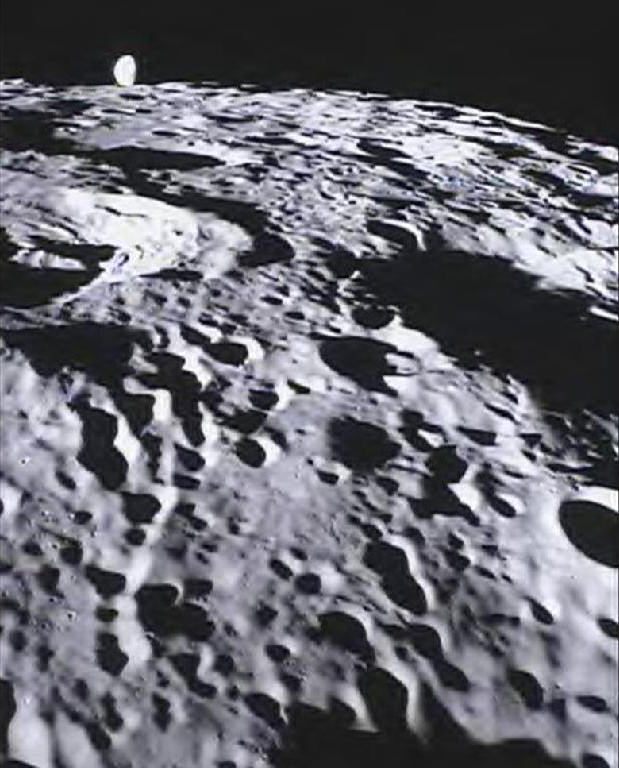
[/caption]
The first student selected photos of the Moon’s surface snapped by NASA’s new pair of student named Lunar Mapping orbiters – Ebb & Flow – have just been beamed back and show an eerie view looking back to the Home Planet – and all of Humanity – barely rising above the pockmarked terrain of the mysterious far side of our nearest neighbor in space.
Congratulations to Americas’ Youth on an outstanding and inspiring choice !!
The student photo is reminiscent of one of the iconic images of Space Exploration – the first full view of the Earth from the Moon taken by NASA’s Lunar Orbiter 1 back in August 1966 (see below).
The images were taken in the past few days by the MoonKAM camera system aboard NASA’s twin GRAIL spacecraft currently circling overhead in polar lunar orbit, and previously known as GRAIL A and B. The formation-flying probes are soaring over the Moon’s north and south poles.
The nearly identical ships were rechristened as Ebb and Flow after Fourth grade students from the Emily Dickinson Elementary School in Bozeman, Mont., won the honor to rename both spacecraft by submitting the winning entries in a nationwide essay competition sponsored by NASA.
“The Bozeman 4th graders had the opportunity to target the first images soon after our science operations began,” said Maria Zuber, GRAIL principal investigator of the Massachusetts Institute of Technology in Cambridge, Mass., to Universe Today.
“It is impossible to overstate how thrilled and excited we are !”
The initial packet of some 66 student-requested digital images from the Bozeman kids were taken by the Ebb spacecraft from March 15-17 and downlinked to Earth March 20. They sure have lots of exciting classwork ahead analyzing all those lunar features !
“GRAIL’s science mapping phase officially began on March 6 and we are collecting science data,” Zuber stated.
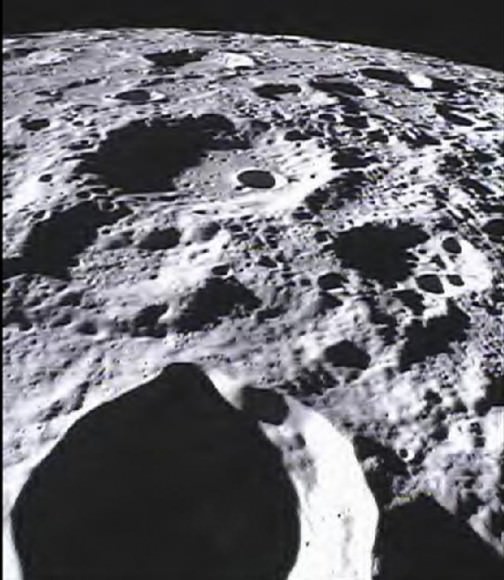
This image of the lunar surface was taken by the MoonKAM system onboard NASA’s Ebb spacecraft on March 15, 2012. The 42.3-mile-wide (68-kilometer-wide) crater in the middle of the image (with the smaller crater inside) is Poinsot. Crater Poinsot, named for the French mathematician Louis Poinsot, is located on the northern part of the moon's far side. The target was selected by 4th grade students at Emily Dickinson Elementary School in Montana who had the honor of choosing the first MoonKAM images after winning a nationwide contest. NASA/Caltech-JPL/MIT/SRS
GRAIL’s science goal is to map our Moon’s gravity field to the highest precision ever. This will help deduce the deep interior composition, formation and evolution of the Moon and other rocky bodies such as Earth and also determine the nature of the Moon’s hidden core.
Engaging students and the public in science and space exploration plays a premier role in the GRAIL project. GRAIL is NASA’s first planetary mission to carry instruments – in the form of cameras – fully dedicated to education and public outreach.
Over 2,700 schools in 52 countries have signed up to participate in MoonKAM.
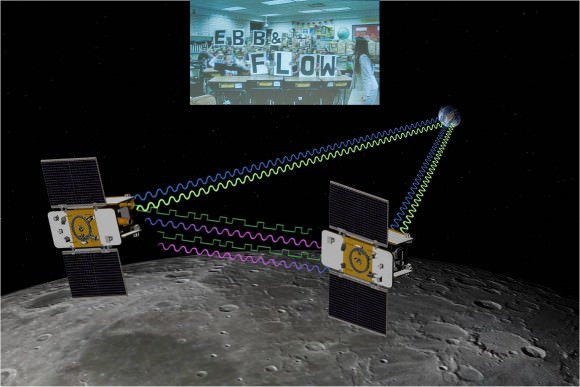
4th Grade Students from Bozeman, Montana (inset) won NASA’s contest to rename the GRAIL A and GRAIL B spacecraft and also chose the first lunar targets to be photographed by the onboard MoonKAM camera system. Artist concept of twin GRAIL spacecraft flying in tandem orbits around the Moon to measure its gravity field Credit: NASA/JPL -M ontage: Ken Kremer
5th to 8th grade students can send suggestions for lunar surface targets to the GRAIL MoonKAM Mission Operations Center at UC San Diego, Calif. Students will use the images to study lunar features such as craters, highlands, and maria while also learning about future landing sites.
NASA calls MoonKAM – “The Universe’s First Student-Run Planetary Camera”. MoonKAM means Moon Knowledge Acquired by Middle school students.
The MoonKAM project is managed by Dr Sally Ride, America’s first female astronaut.
“What might seem like just a cool activity for these kids may very well have a profound impact on their futures,” Ride said in a NASA statement. “The students really are excited about MoonKAM, and that translates into an excitement about science and engineering.”
“MoonKAM is based on the premise that if your average picture is worth a thousand words, then a picture from lunar orbit may be worth a classroom full of engineering and science degrees,” says Zuber. “Through MoonKAM, we have an opportunity to reach out to the next generation of scientists and engineers. It is great to see things off to such a positive start.”
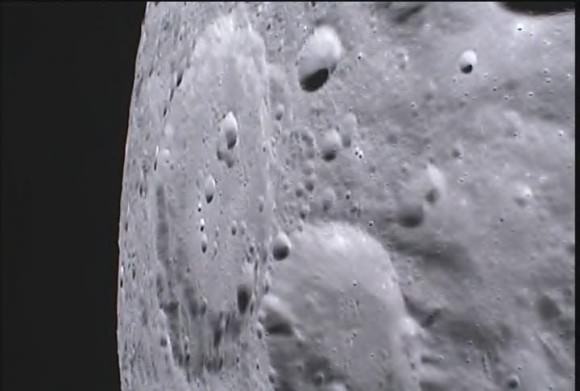
Altogether there are eight MoonKAM cameras aboard Ebb and Flow – one 50 mm lens and three 6 mm lenses. Each probe is the size of a washing machine and measures just over 3 feet in diameter and height.
Snapping the first images was delayed a few days by the recent series of powerful solar storms.
“Due to the extraordinary intensity of the storms we took the precaution of turning off the MoonKAMs until the solar flux dissipates a bit,” Zuber told me.
“GRAIL weathered the storm well. The spacecraft and instrument are healthy and we are continuing to collect science data.”
The washing-machine sized probes have been flying in tandem around the Moon since entering lunar orbit in back to back maneuvers over the New Year’s weekend. Engineers spent the past two months navigating the spaceship duo into lower, near-polar and near-circular orbits with an average altitude of 34 miles (55 kilometers) that are optimized for science data collection and simultaneously checking out the spacecraft systems.
Ebb and Flow were launched to the Moon on September 10, 2011 aboard a Delta II rocket from Cape Canaveral, Florida and took a circuitous 3.5 month low energy path to the moon to minimize the overall costs.
The Apollo astronauts reached the Moon in just 3 days. NASA’s next generation Orion space capsule currently under development will send American astronauts back to lunar orbit by 2021 or sooner.
NASA has just granted an extension to the GRAIL mission. Watch for my follow-up report detailing the expanded science goals of GRAIL’s extended lunar journey.
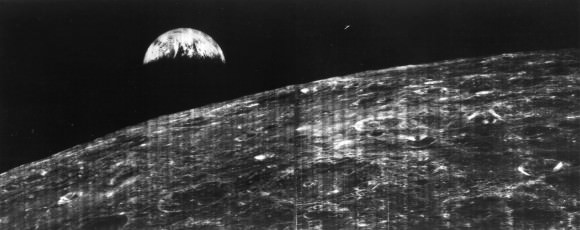
…….
March 24 (Sat): Free Lecture by Ken Kremer at the New Jersey Astronomical Association, Voorhees State Park, NJ at 830 PM. Topic: Atlantis, the End of Americas Shuttle Program, Orion, SpaceX, CST-100, Moon and the Future of NASA Human & Robotic Spaceflight
Twin NASA Science Probes Start Lunar Gravity Mapping
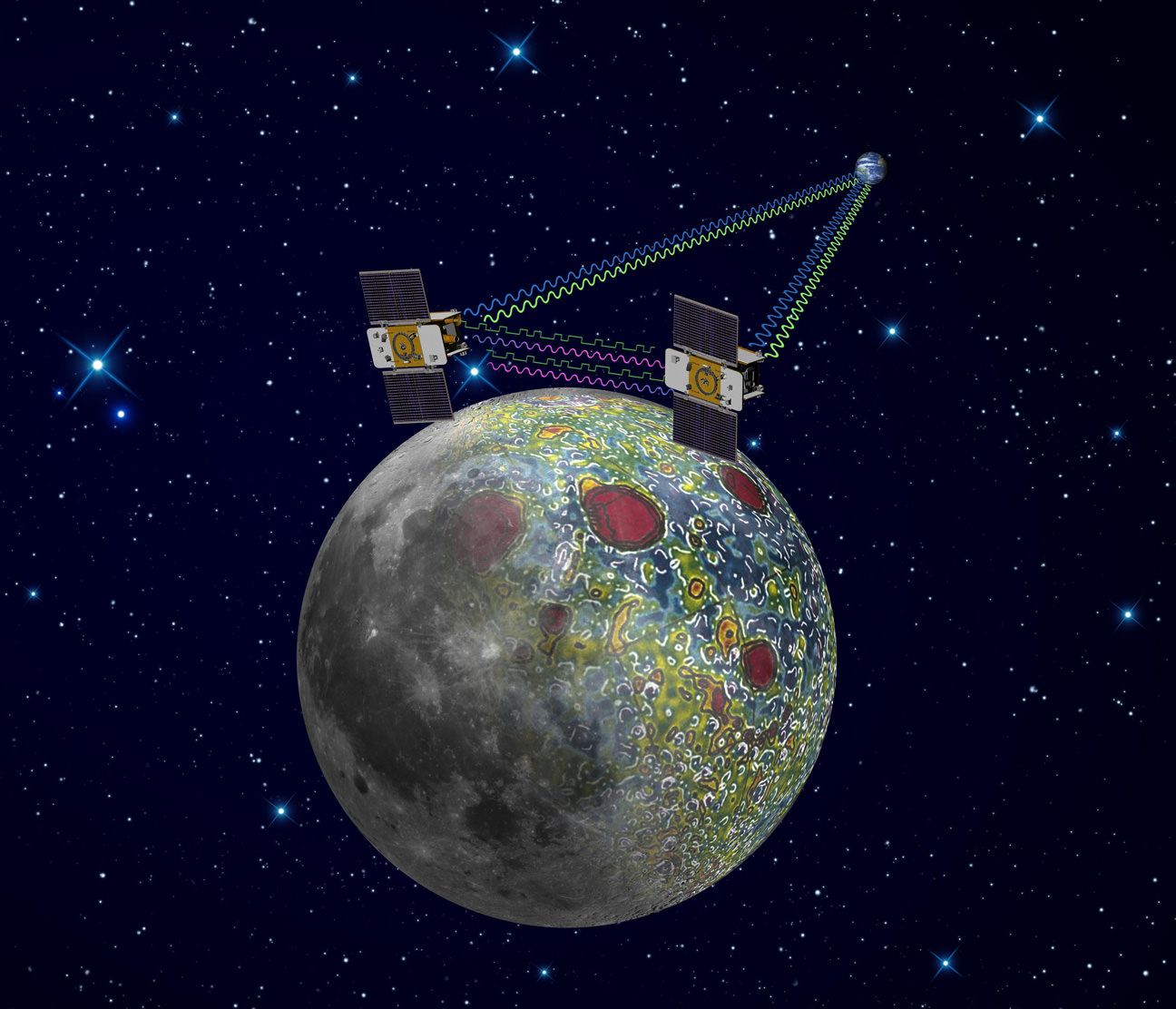
[/caption]
NASA’s twin lunar orbiting GRAIL (Gravity Recovery and Interior Laboratory) spacecraft christened Ebb and Flow have kicked off their science collection phase aimed at precisely mapping our Moon’s gravity field, interior composition and evolution, the science team informed Universe Today.
“GRAIL’s science mapping phase officially began Tuesday (March 6) and we are collecting science data,” said Maria Zuber, GRAIL principal investigator of the Massachusetts Institute of Technology in Cambridge, to Universe Today.
“It is impossible to overstate how thrilled and excited we are !”
“The data appear to be of excellent quality,” Zuber told me.
GRAIL’s goal is to provide researchers with a better understanding of how the Moon, Earth and other rocky planets in the solar system formed and evolved over its 4.5 billion years of history.
NASA’s Dawn spacecraft is currently mapping the gravity field of Asteroid Vesta in high resolution from low orbit.
Despite more than 100 missions to the Moon there is still a lot we don’t know about the Moon says Zuber, like why the near side is flooded with magma and smooth and the back side is rough, not smooth and completely different.
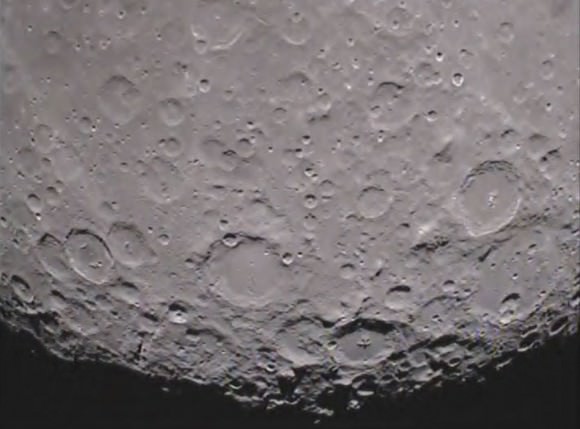
The formation-flying spacecraft will make detailed science measurements from lunar orbit with unparalleled precision to within 1 micron – the width of a human red blood cell – by transmitting Ka-band radio signals between each other and Earth to help unlock the mysteries of the Moon’s deep interior.
“We’ve worked on calibrating the alignment of the Ka-band antennae to establish the optimal alignment. We’ve verified the data pipeline and are spending a lot of time working with the raw data to make sure that we understand its intricacies,” Zuber explained.
The washing-machine sized probes have been flying in tandem around the Moon since entering lunar orbit in back to back maneuvers over the New Year’s weekend. Engineers have spent the past two months navigating the spaceship duo into lower, near-polar and near-circular orbits with an average altitude of 34 miles (55 kilometers), that are optimized for science data collection, and simultaneously checking out the spacecraft systems.
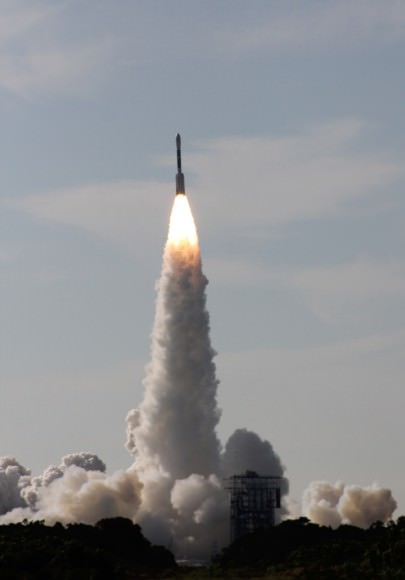
Ebb and Flow were launched to the Moon on September 10, 2011 aboard a Delta II rocket from Cape Canaveral, Florida and took a circuitous 3.5 month low energy path to the moon to minimize the overall costs. The Apollo astronauts reached the Moon in just 3 days.
I asked Zuber to describe the team’s activities putting the mirror image probes to work peering to the central core of our nearest neighbor in unprecedented detail.
“Last Wednesday (Feb. 29) we achieved the science orbit and on Thursday (March 1) we turned the spacecraft to ‘orbiter point’ configuration to test the instrument and to monitor temperatures and power.”
“When we turned on the instrument we established the satellite-to-satellite radio link immediately. All vital signs were nominal so we left the spacecraft in orbiter point configuration and have been collecting science data since then. At the same time, we’ve continued performing calibrations and monitoring spacecraft and instrument performance, such as temperatures, power, currents, voltages, etc., and all is well,” said Zuber.
Measurements gathered over the next 84 days will be used to create high-resolution maps of the Moon’s near side and far side gravitational fields that are 100 to 1000 times more precise than ever before and that will enable researchers to deduce the internal structure and composition of our nearest neighbor from the outer surface crust down to the deep hidden core.
As one satellite follows the other, in the same orbit, they will perform high precision range-rate measurements to precisely measure the changing distance between each other. As they fly over areas of greater and lesser gravity caused by visible features such as mountains, craters and masses hidden beneath the lunar surface, the distance between the two spacecraft will change slightly.
“GRAIL is great. Everything is in place to get science data now,” said Sami Asmar, a GRAIL co-investigator from NASA’s Jet Propulsion Lab in Pasadena, Calif. “Soon we’ll get a very high resolution and global gravity map of the Moon.”
The data collected will be translated into gravitational field maps of the Moon that will help unravel information about the makeup of the Moon’s core and interior composition.
GRAIL will gather three complete gravity maps over the three month mission which is expected to conclude around May 29. If the probes survive a solar eclipse in June and if NASA funding is available, then they may get a bonus 3 month extended mission.
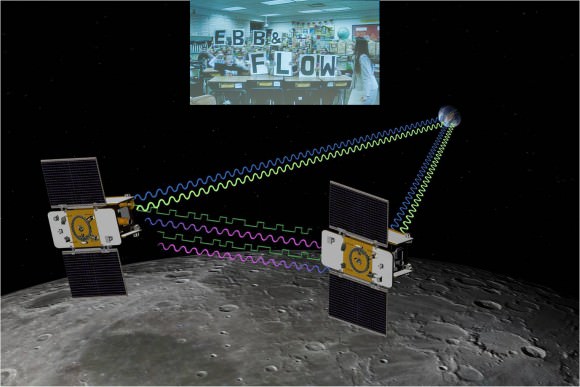
4th Grade Students from Montana (inset) win NASA’s contest to rename the GRAIL A and GRAIL B spacecraft. Artist concept of twin GRAIL spacecraft flying in tandem orbits around the Moon to measure its gravity field Credit: NASA/JPL Montage: Ken Kremer
NASA sponsored a nation-wide student contest for America’s Youth to choose new names for the twin probes originally known as GRAIL A and GRAIL B. 4th graders from the Emily Dickinson Elementary School in Bozeman, Montana submitted the winning entries -Ebb and Flow. The new names won because they astutely describe the probes movements in orbit to collect the science data.
The GRAIL twins are also equipped with a very special camera dubbed MoonKAM (Moon Knowledge Acquired by Middle school students) whose purpose is to inspire kids to study science.
By having their names selected, the 4th graders from Emily Dickinson Elementary have also won the prize to choose the first target on the Moon to photograph with the MoonKAM cameras, which are managed by Dr Sally Ride, America’s first female astronaut.
“MoonKAMs on both Ebb and Flow were turned on Monday, March 5, and all appears well, Zuber said. “The Bozeman 4th graders will have the opportunity to target the first images a week after our science operations begin.”
America’s Youth Christen NASA’s Twin New Lunar Craft – Ebb & Flow
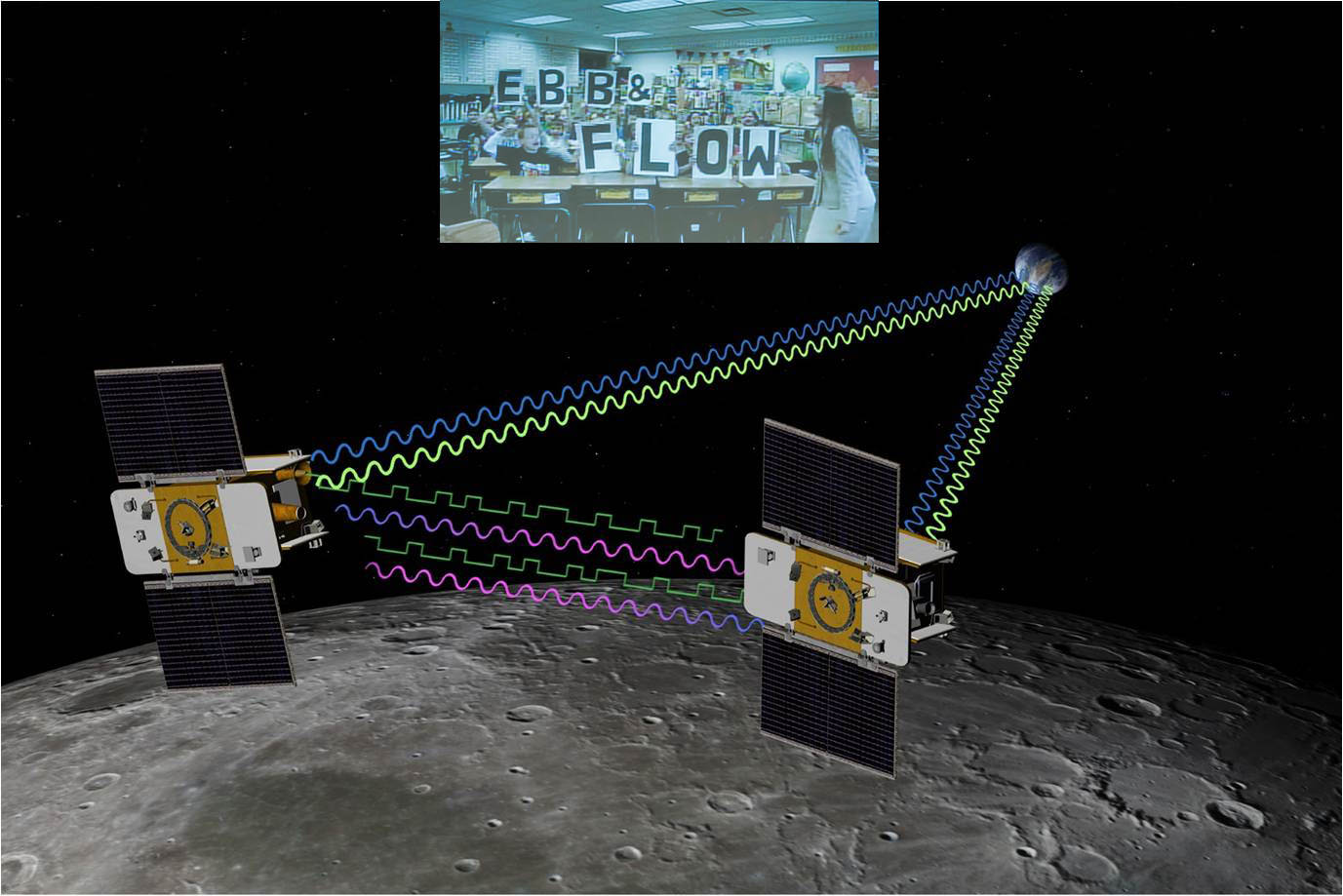
[/caption]
A classroom of America’s Youth from an elementary school in Bozeman, Montana submitted the stellar winning entry in NASA’s nationwide student essay contest to rename the twin GRAIL lunar probes that just achieved orbit around our Moon on New Year’s Eve and New Year’s Day 2012
“Ebb” & “Flow” – are the dynamic duo’s official new names and were selected because they clearly illuminate the science goals of the gravity mapping spacecraft and how the Moon’s influence mightily affects Earth every day in a manner that’s easy for everyone to understand.
“The 28 students of Nina DiMauro’s class at the Emily Dickinson Elementary School have really hit the nail on the head,” said GRAIL principal investigator Prof. Maria Zuber of the Massachusetts Institute of Technology in Cambridge, Mass.
“We asked the youth of America to assist us in getting better names.”
“We chose Ebb and Flow because it’s the daily example of how the Moon’s gravity is working on the Earth,” said Zuber during a media briefing held today (Jan. 17) at NASA Headquarters in Washington, D.C. The terms ebb and flow refer to the movement of the tides on Earth due to the gravitational pull from the Moon.
“We were really impressed that the students drew their inspiration by researching GRAIL and its goal of measuring gravity. Ebb and Flow truly capture the spirit and excitement of our mission.”
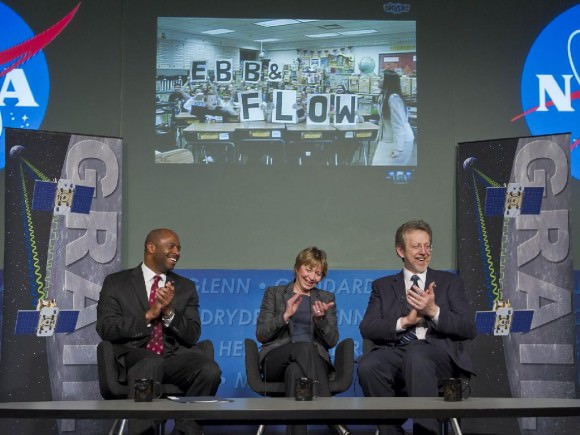
Ebb and Flow are flying in tandem around Earth’s only natural satellite, the first time such a feat has ever been attempted.
As they fly over mountains, craters and basins on the Moon, the spaceships will move back and forth in orbit in an “ebb and flow” like response to the changing lunar gravity field and transmit radio signals to precisely measure the variations to within 1 micron, the width of a red blood cell.
The breakthrough science expected from the mirror image twins will provide unprecedented insight into what lurks mysteriously hidden beneath the surface of our nearest neighbor and deep into the interior.
The winning names from the 4th Graders of Emily Dickinson Elementary School were chosen from essays submitted by nearly 900 classrooms across America with over 11,000 students from 45 states, Puerto Rico and the District of Columbia, Zuber explained.
The students themselves announced “Ebb” and “Flow” in a dramaric live broadcast televised on NASA TV via Skype.
“We are so thrilled that our names were chosen and excited to share this with you. We can’t believe we won! We are so honored. Thank you!” said Ms. DiMauro as the very enthusiastic students spelled out the names by holding up the individual letters one-by-one on big placards from their classroom desks in Montana.
Watch the 4th Grade Kids spell the names in this video!
Until now the pair of probes went by the rather uninspiring monikers of GRAIL “A” and “B”. GRAIL stands for Gravity Recovery And Interior Laboratory.
The twin crafts’ new names were selected jointly by Prof. Zuber and Dr. Sally Ride, America’s first woman astronaut, and announced during today’s NASA briefing.
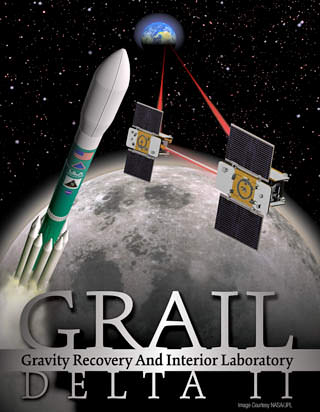
NASA’s naming competition was open to K-12 students who submitted pairs of names and a short essay to justified their suggestions.
“Ebb” and “Flow” (GRAIL A and GRAIL B) are the size of washing machines and were launched side by side atop a Delta II booster rocket on September 10, 2011 from Cape Canaveral, Florida.
They followed a circuitous 3.5 month low energy path to the Moon to minimize the fuel requirements and overall costs.
So far the probes have completed three burns of their main engines aimed at lowering and circularizing their initial highly elliptical orbits. The orbital period has also been reduced from 11.5 hours to just under 4 hours as of today.
“The science phase begins in early March,” said Zuber. At that time the twins will be flying in tandem at 55 kilometers (34 miles) altitude.
The GRAIL twins are also equipped with a very special camera dubbed MoonKAM (Moon Knowledge Acquired by Middle school students) whose purpose is to inspire kids to study science.
“GRAIL is NASA’s first planetary spacecraft mission carrying instruments entirely dedicated to education and public outreach,” explained Sally Ride. “Over 2100 classrooms have signed up so far to participate.”
Thousands of middle school students in grades five through eight will select target areas on the lunar surface and send requests for study to the GRAIL MoonKAM Mission Operations Center in San Diego which is managed by Dr. Ride in collaboration with undergraduate students at the University of California in San Diego.
By having their names selected, the 4th graders from Emily Dickinson Elementary have also won the prize to choose the first target on the Moon to photograph with the MoonKam cameras, said Ride.
Zuber notes that the first MoonKAM images will be snapped shortly after the 82 day science phase begins on March 8.
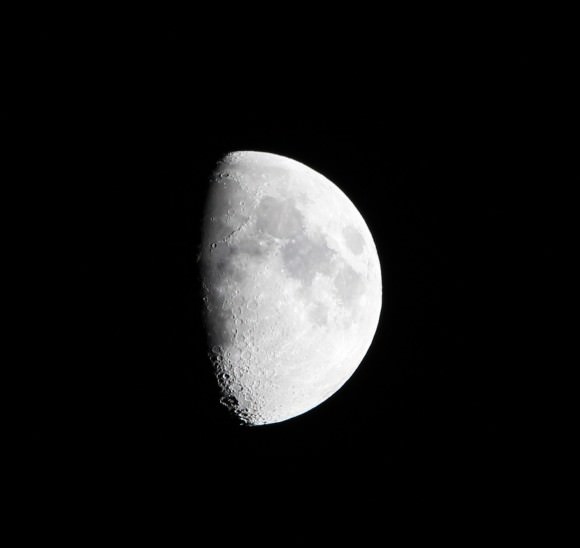
NASA’s twin GRAIL-A & GRAIL-B spacecraft are orbiting the Moon in this astrophoto taken on Jan. 2, 2012 shortly after successful Lunar Orbit Insertions on New Year’s Eve and New Year’s Day 2012.
Credit: Ken Kremer
Read continuing features about GRAIL and the Moon by Ken Kremer here:
Dazzling Photos of the International Space Station Crossing the Moon!
Two new Moons join the Moon – GRAIL Twins Achieve New Year’s Orbits
First GRAIL Twin Enters Lunar Orbit – NASA’s New Year’s Gift to Science
2011: Top Stories from the Best Year Ever for NASA Planetary Science!
NASA’s Unprecedented Science Twins are GO to Orbit our Moon on New Year’s Eve
Student Alert: GRAIL Naming Contest – Essay Deadline November 11
GRAIL Lunar Blastoff Gallery
GRAIL Twins Awesome Launch Videos – A Journey to the Center of the Moon
NASA launches Twin Lunar Probes to Unravel Moons Core
GRAIL Unveiled for Lunar Science Trek — Launch Reset to Sept. 10
Last Delta II Rocket to Launch Extraordinary Journey to the Center of the Moon on Sept. 8
NASAs Lunar Mapping Duo Encapsulated and Ready for Sept. 8 Liftoff
GRAIL Lunar Twins Mated to Delta Rocket at Launch Pad
GRAIL Twins ready for NASA Science Expedition to the Moon: Photo Gallery

